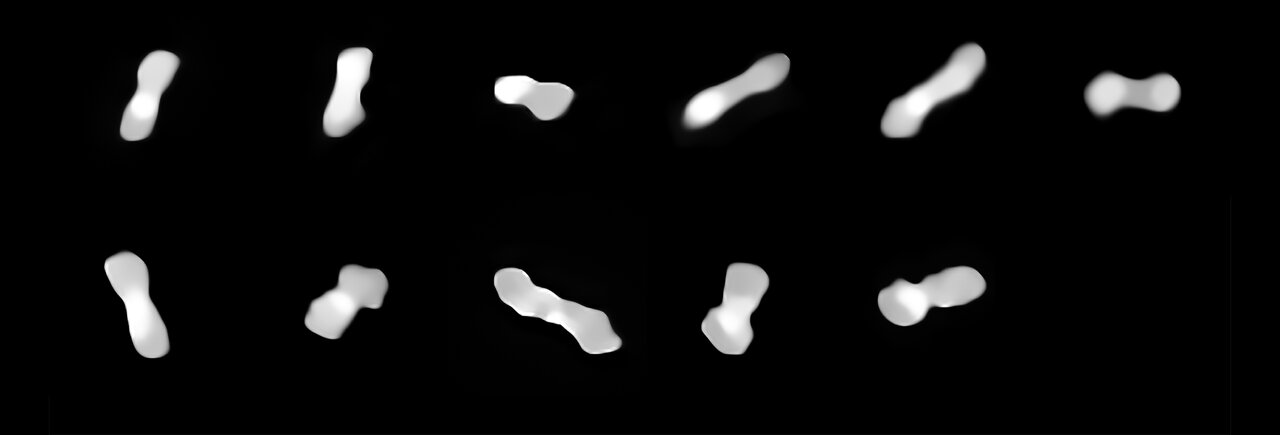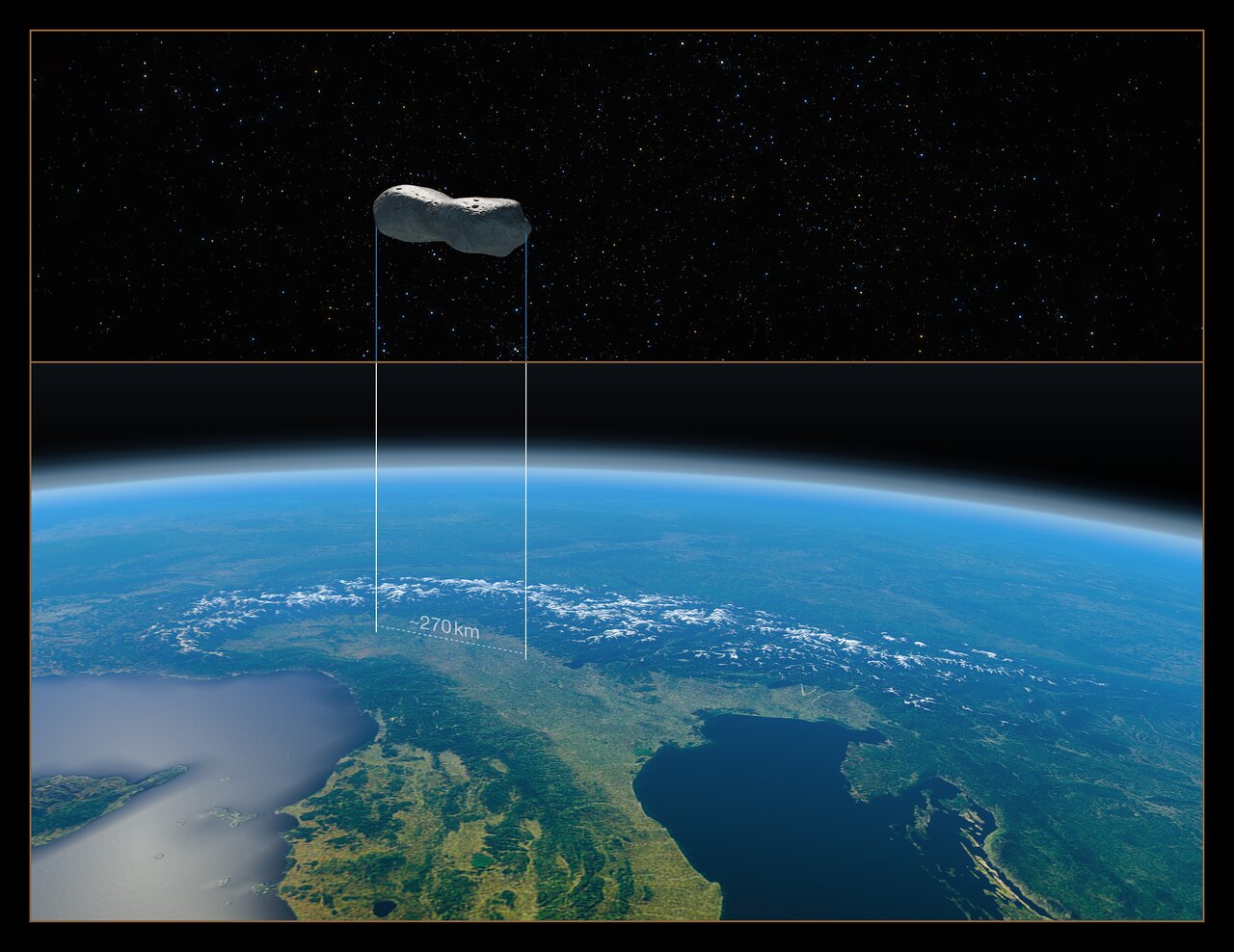Scientists fetch best images to date of 'dog bone' asteroid and 2 tiny moons
Dogged observations helped scientists sniff out a better understanding of the space rock.
New observations of an asteroid shaped like a dog bone and its two tiny moons have given scientists insight into how the strange trio came to be.
An astronomer first spotted the space rock Kleopatra among other such space rocks in the asteroid belt between Mars and Jupiter in 1880, but in the past few decades, scientists have realized that the main space rock sports a strange shape and two tiny moons. And researchers suggested that wasn't the end of surprises from Kleopatra. So, a team of scientists arranged to study the space rock using the Very Large Telescope based in Chile.
"Kleopatra is truly a unique body in our solar system," Franck Marchis, an astronomer at the SETI Institute in California and at the Laboratoire d'Astrophysique de Marseille, France, who led new research on the asteroid, said in a statement.
"Science makes a lot of progress thanks to the study of weird outliers," he added. "I think Kleopatra is one of those and understanding this complex, multiple asteroid system can help us learn more about our solar system."
Related: The greatest asteroid encounters of all time!
Read more: The 7 strangest asteroids in the solar system

In 2008, Marchis and his colleagues had spotted Kleopatra's two moons, AlexHelios and CleoSelene, named for two children of ancient Egypt's most famous queen. But even after the discovery, scientists wanted to keep an eye on the system — and observing the asteroid from 2017 to 2019 has finetuned researchers' picture of Kleopatra.
Those new observations come from the Very Large Telescope's Spectro-Polarimetric High-contrast Exoplanet Research (SPHERE) instrument. As the name suggests, the instrument was originally developed to spot alien planets, according to the European Southern Observatory (ESO), which operates the facility. That research requires spotting dim exoplanets around bright stars, so SPHERE is well-positioned to pick out the tiny moons orbiting the bright main body of Kleopatra 120 million miles (200 million kilometers) away from Earth.
Get the Space.com Newsletter
Breaking space news, the latest updates on rocket launches, skywatching events and more!
And conveniently enough, the instrument is also equipped with a high-power adaptive optics system to adjust images for the blur that Earth's atmosphere otherwise causes. The result is super-sharp photographs, even inside the solar system.

So the researchers used SPHERE to snap a series of images of Kleopatra. Because the images were so sharp, scientists could use them to finetune models of the main chunk of Kleopatra and to pinpoint how the two moons AlexHelios and CleoSelene orbit the larger body.
In the process, the researchers determined that previous orbital models for those two small moons were incorrect. That's a big deal, since scientists use the relationship between a body and its moons to understand the gravity at play and in turn the mass of the asteroid.
"This had to be resolved," Miroslav Brož, a solar system scientist at Charles University in the Czech Republic, said in the statement. "Because if the moons' orbits were wrong, everything was wrong, including the mass of Kleopatra."
With the new orbital data, scientists determined that Kleopatra is about 35% less massive than previous calculations estimated. The new value, plus sharpened models of the asteroid's size, suggests that the asteroid isn't as dense as scientists had believed, despite the fact that scientists think the object is metallic. That paradox suggests that Kleopatra has a "rubble pile" structure with lots of gaps in it, much like the asteroids Ryugu and Bennu that spacecraft have visited to study up close in recent years.

Rubble pile asteroids likely form from debris coalescing after a giant impact, but the new analysis also suggests that AlexHelios and CleoSelene came from Kleopatra itself. That theory is based on the determination that Kleopatra is spinning so quickly that if it sped up much it would simply fling itself to pieces. According to the researchers, that means that even collisions with small rubble might pull pebbles off the main asteroid's surface that could then coalesce into the moons.
And scientists haven't yet ruled out that there could be other tiny moons orbiting Kleopatra. However, researchers will need to wait for more powerful instruments to see any such bodies. One possible tool will be ESO's Extremely Large Telescope, or ELT, scheduled to begin observing later this decade.
"I can't wait to point the ELT at Kleopatra, to see if there are more moons and refine their orbits to detect small changes," Marchis said.
The research is described in two papers published Thursday (Sept. 9) in the journal Astronomy & Astrophysics.
Email Meghan Bartels at mbartels@space.com or follow her on Twitter @meghanbartels. Follow us on Twitter @Spacedotcom and on Facebook.
Join our Space Forums to keep talking space on the latest missions, night sky and more! And if you have a news tip, correction or comment, let us know at: community@space.com.

Meghan is a senior writer at Space.com and has more than five years' experience as a science journalist based in New York City. She joined Space.com in July 2018, with previous writing published in outlets including Newsweek and Audubon. Meghan earned an MA in science journalism from New York University and a BA in classics from Georgetown University, and in her free time she enjoys reading and visiting museums. Follow her on Twitter at @meghanbartels.









